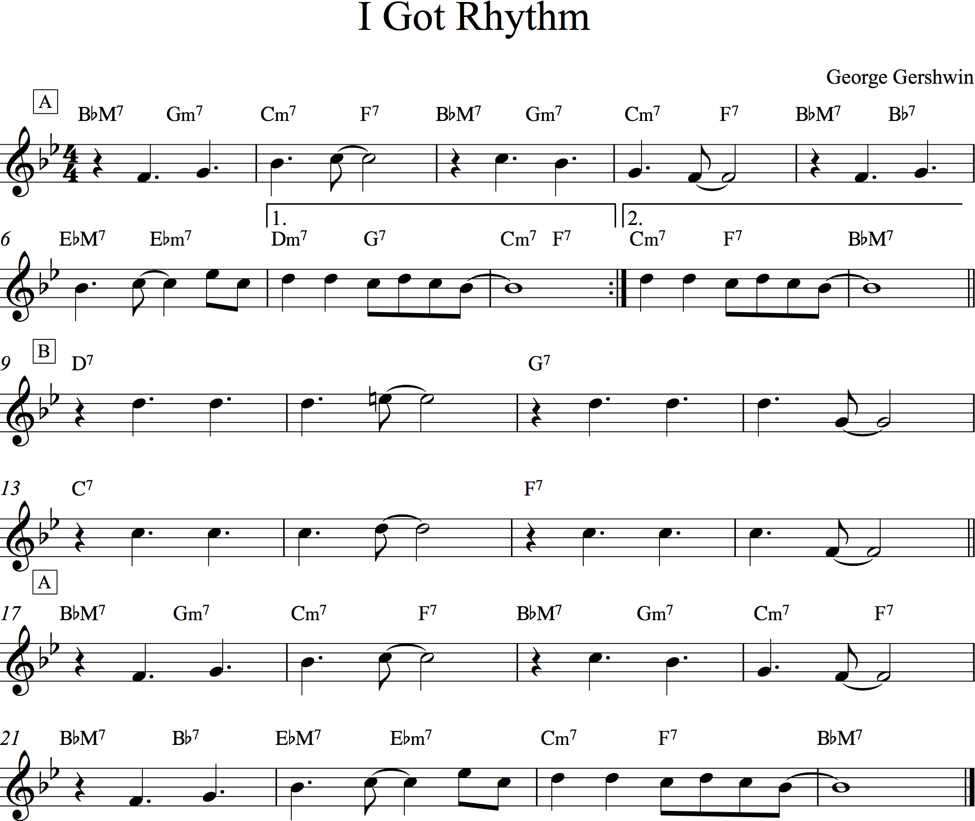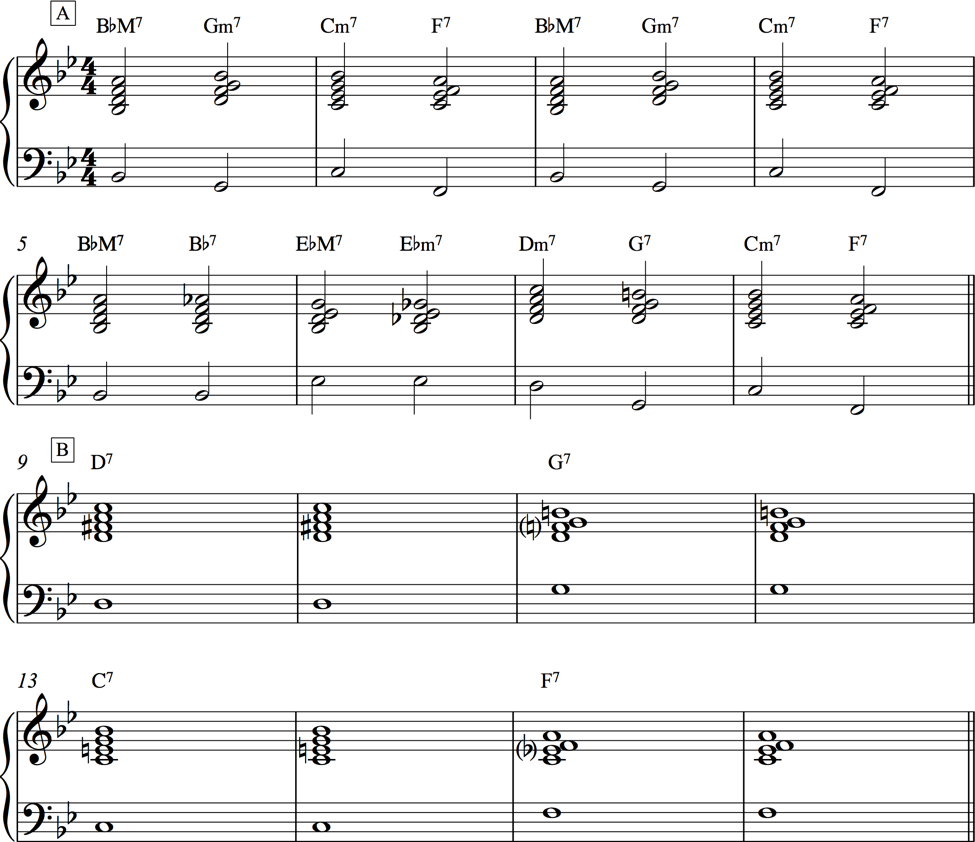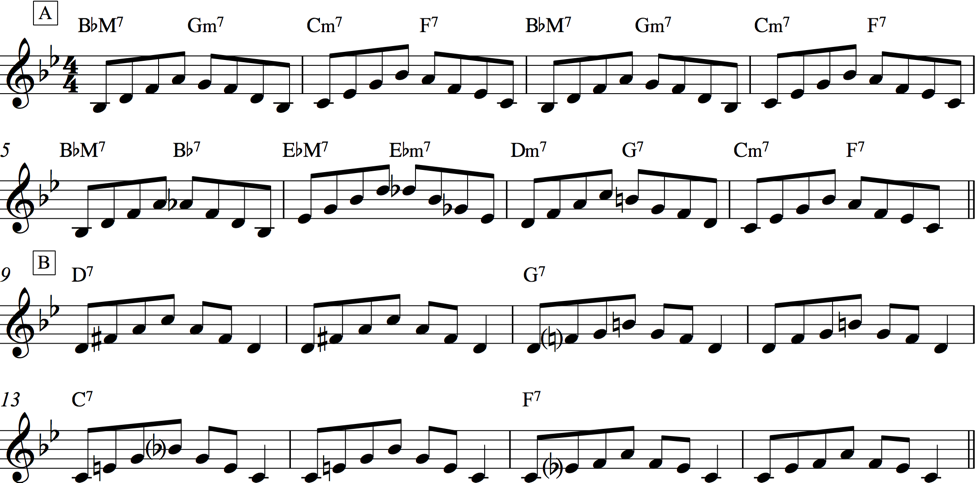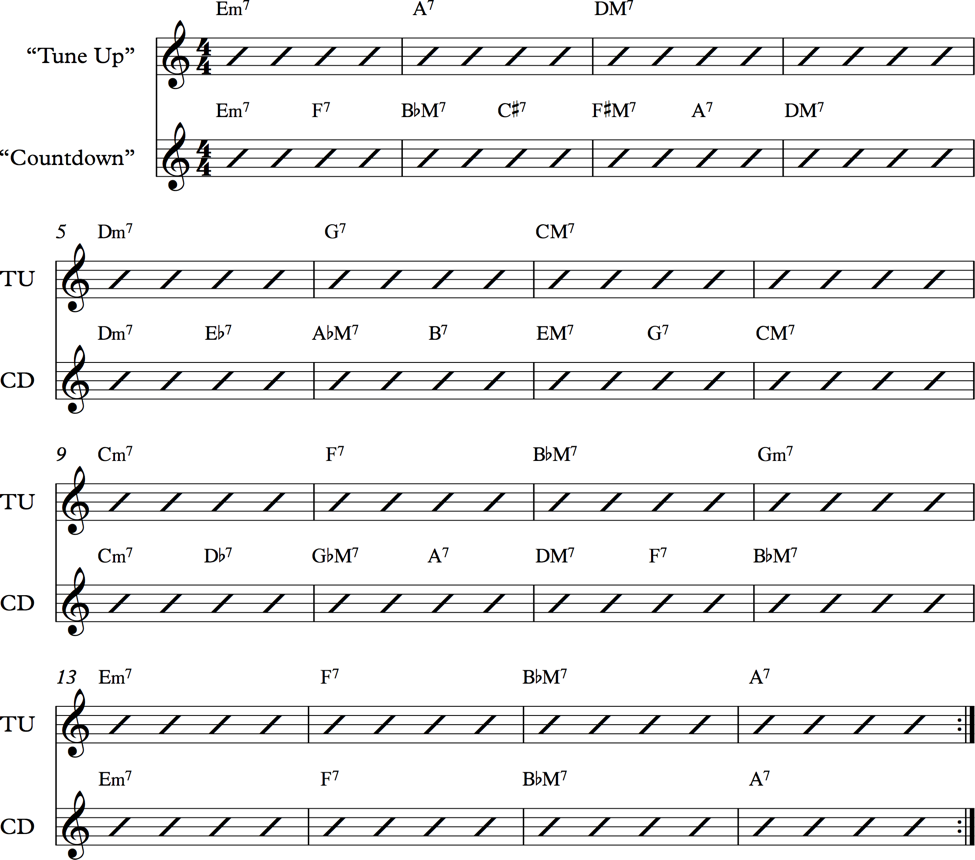Engaging Students: Essays in Music Pedagogy, vol. 4, Engaging Students Through Jazz
Rhythm Changes, Improvisation, and Chromaticism: Who Could Ask for Anything More?
Garrett Michaelsen, University of Massachusetts Lowell
I Got Rhythm
After the 12-bar blues, no chord progression is more important to jazz than Rhythm changes. It epitomizes a number of qualities of jazz style: the appropriation of an American popular song, in this case “I Got Rhythm” by George and Ira Gershwin, for the purposes of limitless improvisation and variation; the repeating AABA form; the use of common harmonic schemas; and the rich history of alteration and reharmonization musicians have brought to it. The chord progression is worth class time on its own due to its importance to 20th-century music; jazz composers spanning many decades, from Duke Ellington to Charlie Parker to Ornette Coleman, have all based compositions on Rhythm changes. Beyond its historical value, teaching Rhythm changes in music theory classrooms offers two important benefits: first, it provides an ideal environment for students to explore secondary dominant chords through improvisation. Second, Rhythm changes offers a perfect canvas for the application of substitution and reharmonization processes, enabling a different perspective on chromaticism than is typically discussed in theory curricula. In this essay, I will outline the various activities I use in my classes that explore these two topics.
I Got Secondary Dominants
There is no standard version of Rhythm changes. Jazz musicians began adapting Gershwin’s “I Got Rhythm” from the very beginning, resulting in myriad variations. The tune was probably attractive to jazz musicians due to its harmonic and formal simplicity, giving a simple foundation on which to build. Figure 1 provides the version of Rhythm changes that I use in my classes. (See the linked PDF for lead sheets in C, B♭, E♭, and F transpositions, as well as bass clef.) While Gershwin’s original version had a 34-bar AABA form that included a “one more time” cadential repetition in the final A, jazz musicians typically regularize it into 32 measures with eight-bar sections. The A and B sections consist of simple yet distinct harmonic trajectories: I7–vi7–ii7–V7 progressions in bars 1–4, tonicization of IV in mm. 5–6, turnaround changes in mm. 7–8 of the A section’s first ending, and a chain of secondary dominants in the B section. I use Rhythm changes as the centerpiece of a unit that introduces secondary-dominant chromaticism.
Figure 1. “I Got Rhythm” lead sheet.

After distributing the lead sheet to students, we work through the tune as a class, attempting to make sense of the chord symbols by assigning them Roman numerals. The first four bars offer few difficulties, but the next four provide ample opportunities for introducing the concept of secondary functions. The first chromatic chord, B♭7 in m. 5, provides an excellent introduction to the topic, as it emerges seamlessly as a chromatic alteration of the preceding B♭M7 tonic chord, and resolves as expected to its secondary tonic, E♭M7. The turnaround in mm. 7–8 provides an opportunity for discussing how the Dm7 chord, at first conceptualized as iii, can be thought of as an applied ii chord participating in a secondary ii7–V7 applied to C minor, which is then sequenced in the following bar as the primary ii7–V7. This analysis resonates particularly well with jazz harmonic practice, in which musicians view the ii7–V7–I7 as the underlying schema for most harmonic progressions. Turning to the bridge, students are now prepared for dealing with the chromatic D7 chord, and readily identify it as V7/vi. When it resolves to G7, however, they are surprised! This leads naturally to a discussion of elided or deferred resolutions of secondary dominants, creating the chain that eventually reaches its conclusion on F7, the primary dominant.
After analyzing Rhythm changes, I have students practice realizing it at the piano in preparation for improvising melodic lines over it using either their voice or an instrument of their choosing. There are many possible ways of performing the progression at the piano based on student ability. Figure 2 demonstrates one possible realization students might perform using seventh chords and common voice leading, and preferring patterns starting on root-position ii7 chords (see the linked PDF for examples of these ii7–V7–I7 patterns in all twelve major keys). Realizing lead-sheet chords at the keyboard creates an immediate aural–tactile connection between the harmonies-as-conceptualized and harmonies-as-heard, setting them up to succeed at improvising melodic lines over those chords.
Figure 2. Rhythm changes keyboard chords.

As I have argued elsewhere, improvisation provides an ideal medium for students to learn and explore music theory. When using melodic improvisation to teach students harmonic concepts, my primary focus is on them inventing a line that emphasizes chord tones in time with the unfolding progression. An essential introductory scaffold for playing Rhythm changes is to have students arpeggiate up and/or down each seventh chord in eighth notes, both vocally and on their instrument. This should be done in two ways: first, they perform each arpeggio starting on root pitches as demonstrated in Figure 3. Second, they strive to connect chord tones more smoothly as they do when performing them on piano, but now as an arpeggiated single line. Given the two-chords-per-bar harmonic rhythm of the A sections, there is enough time to arpeggiate up the first chord, shift down to the closest neighboring pitch of the second, and then continue down before reaching the next measure. The leisurely two-bars-per-chord pace of the B section allows motion through each arpeggio twice before finding the smoothest connections to the following dominant chord. Figure 4 notates one way of performing this arpeggiated scaffold.
Figure 3. Root-position chord arpeggios on Rhythm changes.

Figure 4. Chord arpeggios with smooth voice leading on Rhythm changes.

Once students are comfortable playing the progression as an arpeggiated line, we begin making the leap towards improvising a more varied and creative melody. At first, I instruct them to keep the chordal arpeggiations in mind but add in more rhythmic variety, leaving out some of the pitches, sustaining others, and playing them in new arrangements. Figure 5 provides one example of how this might sound over the A section. This is an especially good technique for dealing with the A section, given the brisk rate at which each chord appears. I then instruct them to add passing tones in between the chord tones, filling in the gaps with melodic steps diatonic to the home key (see Figure 6 for a hypothetical improvisation). When dealing with the B section, I introduce the notion of chord–scale equivalency common in jazz pedagogy and have students practice running Mixolydian scales up and down in time with the progression, as shown in Figure 7. The large difference in harmonic rhythm between the two sections gives students the opportunity to focus on chordal arpeggiations in the A sections and scalar representations in the B section. I also encourage them to look for interesting chromatic lines that bridge the boundaries between chords. One such line that I have the class practice begins in m. 5 and is notated in Figure 8. Emphasizing moments of chromatic change, arpeggiating chord tones, and filling in the gaps with scale tones are important ways of outlining a harmonic structure that will enable students to produce sophisticated melodic improvisations.
Figure 5. Example improvisation over the A section of Rhythm changes based on chordal arpeggiations.

Figure 6. Example improvisation over mm. 1–4 of Rhythm changes that incorporates passing tones between chord tones.

Figure 7. Mixolydian scales in the B section of Rhythm changes.

Figure 8. Chromatic line in mm. 5–7 of A section of Rhythm changes.

Given that improvisation is a complex and authentic activity, adding in supportive scaffolds like these is essential for setting up students for success, particularly those with little to no prior experience. In the course of students’ improvisations, I often jump in and have the whole class repeat back interesting melodic ideas that the improviser comes up with. This gives the improviser praise while also engaging the rest of the class, giving them a melodic phrase to repeat and add to their personal lexicons. More of the class may be involved while waiting their turn by designating a rhythm section out of the group, with a few students providing chordal accompaniment on piano and guitar, some outlining chordal roots either vocally or on a bass-register instrument, and others providing a percussive backdrop by clapping, tapping, or playing drum kit. By experiencing the common harmonic schemas and secondary-dominant chromaticism inherent in Rhythm changes through analysis, keyboard performance, and melodic improvisation, students internalize and personalize their knowledge of these concepts, solidifying their understanding and leading into other musical styles and activities.
I Got Reharmonization
Once students have worked their way through the typical topics of common-practice chromaticism, I return to Rhythm changes as a platform for discussing reharmonization and substitution in jazz. While reharmonization is an important process in common-practice traditions (such as in Bach chorales and theme transformations in sonata recapitulations), it is not significantly emphasized in music theory curricula. In jazz, the reliance on the ii7–V7–I7 progression as an omnipresent schema, the desire for variation when performing over repeating formal cycles, and the real-time realization of harmony through improvisation have made reharmonization a core topic in jazz pedagogy. As a result, jazz musicians not only learn common harmonic patterns, but also ways of transforming those patterns in characteristic and personal ways. Jazz’s use of chord symbols encourages this “mix and match” approach to harmony: one chord symbol, as a representative of a harmony, can be easily exchanged for another, based on a number of common techniques. These chord symbols may also be chromatically altered or extended beyond the core seventh chord. By introducing students to techniques of alteration and substitution, they can learn to create striking chromatic reharmonizations of simple chord structures. Having introduced them to Rhythm changes earlier, students can now use its simple structure for experimentation with these processes.
Jazz musicians often expand on three of the foundational chord symbols in jazz, major-, minor-, and dominant-seventh chords, through the inclusion of these chords’ upper-extension 9ths, 11ths, and 13ths. These extensions may also be chromatically altered in characteristic ways, producing sonorities that stretch the common-practice definitions of consonance and dissonance. This linked PDF summarizes the most common extended chords and gives basic voicings that typically include the root, third, seventh, and upper extensions, with typical chromatic alterations. Students first practice notating individual chords and then whole chord progressions from lead sheets. This requires them to consider the horizontal connections between chords, resolve sevenths down, retain common tones, and aim for smooth connections between chords. Jazz tunes that make good candidates for chord notation in this manner include “Nefertiti,” “Invitation,” “Stella by Starlight,” and “Peace,” all included in volume 1 of The Real Book. Once they have experience notating and connecting extended chords given in a lead sheet, I have them experiment by applying these chords to lead sheets that do not include any such alterations.
After discussing extended chords, I next introduce students to a few common substitution and reharmonization processes. While my discussion here will be necessarily brief, Dariusz Terefenko provides a comprehensive introduction in chapters 13 and 25 of his book Jazz Theory. As mentioned above, jazz harmonic practice is rooted extensively on the ii7–V7–I7 schema. Some pedagogues such as Mark Levine even go so far as to think of any minor chord as a “ii7” chord, any dominant chord as a “V7”, and any major chord as a “I7”, irrespective of their local or global tonal context. This conceptualization has been critiqued by Robert Rawlins, but it does provide an important practical benefit: it enables musicians to reproduce memorized chord voicings or melodic patterns that fit over these archetypal categories more facilely, thereby reducing their cognitive load when improvising. Moreover, it is this reduction of most harmonic motion to the ii7–V7–I7 that enables many of the substitutional processes integral to jazz. By assuming a single prototypical chord progression as the underlying norm, jazz musicians may transform this structure to produce myriad results.
One of the most basic substitution processes is the replacement of a secondary dominant chord for any ii7 chord participating in a ii7–V7 schema. Such schemas abound in Rhythm changes, as they do in most jazz. Students especially respond to the realization that, when substituting D7 and C7 for Dm7 and Cm7 in the A section’s turnaround in mm. 7–8, this progression transforms into the same one that appears in the B section. Another simple transformation is the addition of a ii7 chord in front of any stand-alone dominant chord. This change rests on the archetypal status of the ii7–V7; any lone V7 chord is by this logic “missing” its ii7. The B section’s chain of secondary dominants offers the best application of this process, producing the following progression when applied across all eight bars: Am7–D7, Dm7–G7, Gm7–C7, Cm7–F7.
The signature substitution in jazz is the tritone substitution. In its most common form, jazz musicians substitute the V7 chord in a ii7–V7–I7 with a chord whose root lies a tritone away, thereby producing ii7–♭II7–I7. Central to the logic of this transformation is that the third–seventh pair, the essential identifying chord members in jazz, of the V7 and ♭II7 chords are enharmonically equivalent, and that the resulting bass line produces a satisfying chromatic descent. Jazz musicians take the technique of tritone substitution even further, however, and often apply it to ii7 chords as well, producing ♭vi7–♭II7–I progressions. This substitution may also be conceptualized as overwriting the diatonic ii7 chord with the tritone-substituted dominant’s ii7 chord. In these substitutions, the thirds and sevenths of the substituted ♭vi7 and ii7 chords are not enharmonically equivalent, and as a result musicians will often alter these chords to be dominant-seventh ♭VI7 chords. This change results from a two-step substitutional process: the ii7 chord is first changed to V7/V, which is then changed to ♭II7/V, or ♭VI7. As Nicole Biamonte has pointed out, this process results in a chord very similar to the “German” augmented-sixth chord. While she distinguishes between the two based on voice-leading tendencies and chord function, they may also be considered the result of two related but distinct processes: divergent linear trajectories in the case of the German augmented-sixth chord (a “chord” in name only) and chord-symbol substitution, informed by linear enharmonicism, in the case of the tritone substitution.
The final reharmonization technique I discuss with my students is one that John Coltrane pioneered in certain compositions from the late 1950s. In tunes like “Countdown,” Coltrane explores cycles of V7–I7 and ii7–V7–I7 progressions based on keys related by major and minor thirds rather than the typical fifths. “Countdown” is itself a reharmonization of Miles Davis’s (or possibly Eddie Vinson’s) “Tune Up,” a tune that consists of four-bar ii7–V7–I7 progressions that are sequenced down by step three times over the first twelve measures (the two tunes are compared in Figure 9). In “Countdown,” Coltrane begins on the same ii7, but then shifts up by half step to a V7 chord that sets off a chain of V7–I7 motions in keys a major third apart. Thus Davis’s Em7–A7–DM7 becomes Coltrane’s Em7–F7–B♭M7–D♭7–G♭M7–A7–DM7. Since there are no leisurely four-bar ii7–V7–I7 progressions in Rhythm changes, finding a location to apply Coltrane’s “Countdown” technique requires a bit of creative thinking. The best spot occurs in m. 2, beginning on the ii7 chord and resolving to I7 in m. 5, as shown in Figure 10.
Figure 9. Comparison between “Tune Up” and “Countdown.”

Figure 10. Rhythm changes A section with “Countdown” transformation.

Having introduced the class to chordal extensions, chromatic alteration of those extensions, addition of ii7 chords, secondary-dominant and tritone substitutions, and Coltrane changes, I distribute this linked PDF, which summarizes these techniques and demonstrates their use in a one-chorus reharmonization of Rhythm changes. I have students try their hand at reharmonizing other tunes, with good candidates being “Autumn Leaves” and “All The Things You Are.” While these techniques do not begin to fully describe jazz reharmonization practice, they give students plenty to work with in order to produce their own novel versions of standard tunes. By looking at chromaticism through the lens of reharmonization, students learn to treat harmonic prototypes more flexibly, enabling them to be more creative when composing or improvising on their own.
Who Could Ask for Anything More?
As music theory curricula become more and more pluralistic, Rhythm changes is an exemplary candidate for inclusion due to the many avenues it opens for students to explore chromaticism. Through learning and improvising over Rhythm changes, students will not only be exposed to an important 20th-century musical tradition, but will also more deeply ingrain common harmonic schemas and chromatic chords in their ears, fingers, and minds. Relying on that knowledge to introduce the vibrant practice of jazz reharmonization opens a new window on chromaticism, one that gives students a concrete way of embellishing harmonic prototypes through substitutional processes. Rhythm changes is a harmonic framework that exists to be explored and modified, helping to tear down the “imaginary museum of musical works.” It is possible to imagine ways of “improvising on” works of the common-practice period in a similar way, either by extracting their chord progressions or reharmonizing their melodies. Students learn best when they come at an idea from as many angles as possible; adding Rhythm changes to music theory curricula provides a prismatic approach that can deepen and broaden their understanding of chromatic harmony.
This work is copyright ⓒ2016 Garrett Michaelsen and licensed under a Creative Commons Attribution–ShareAlike 3.0 Unported License.